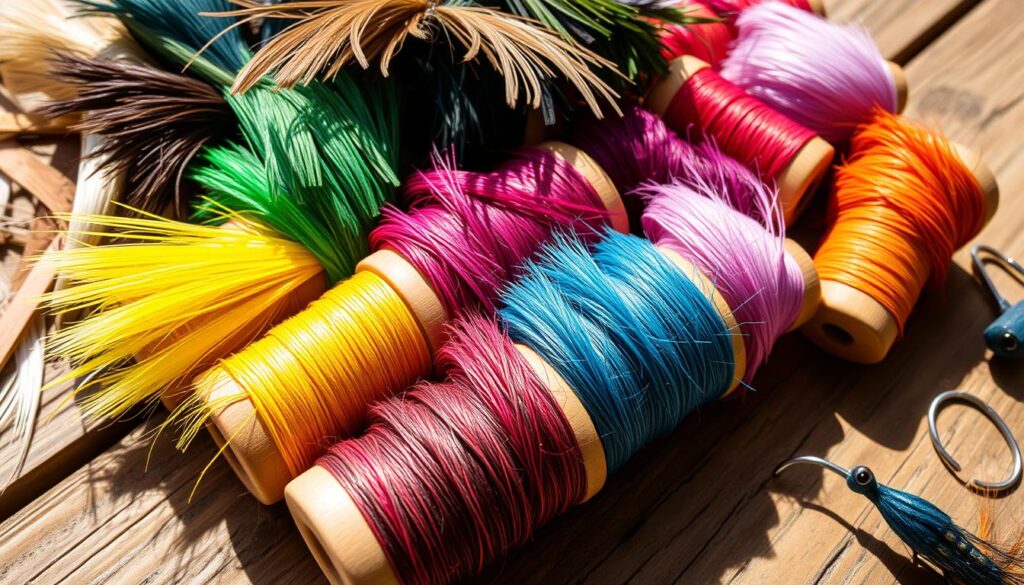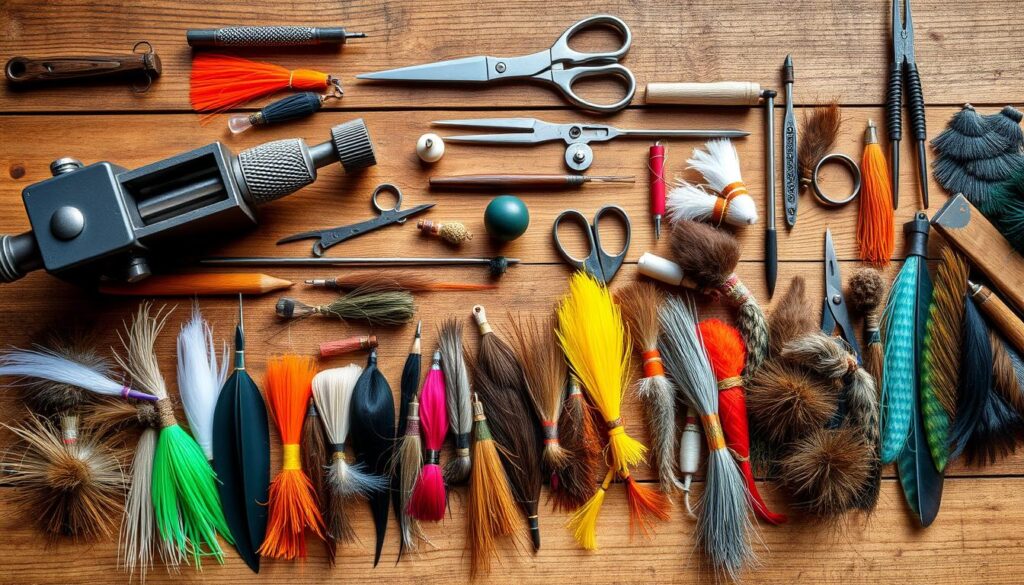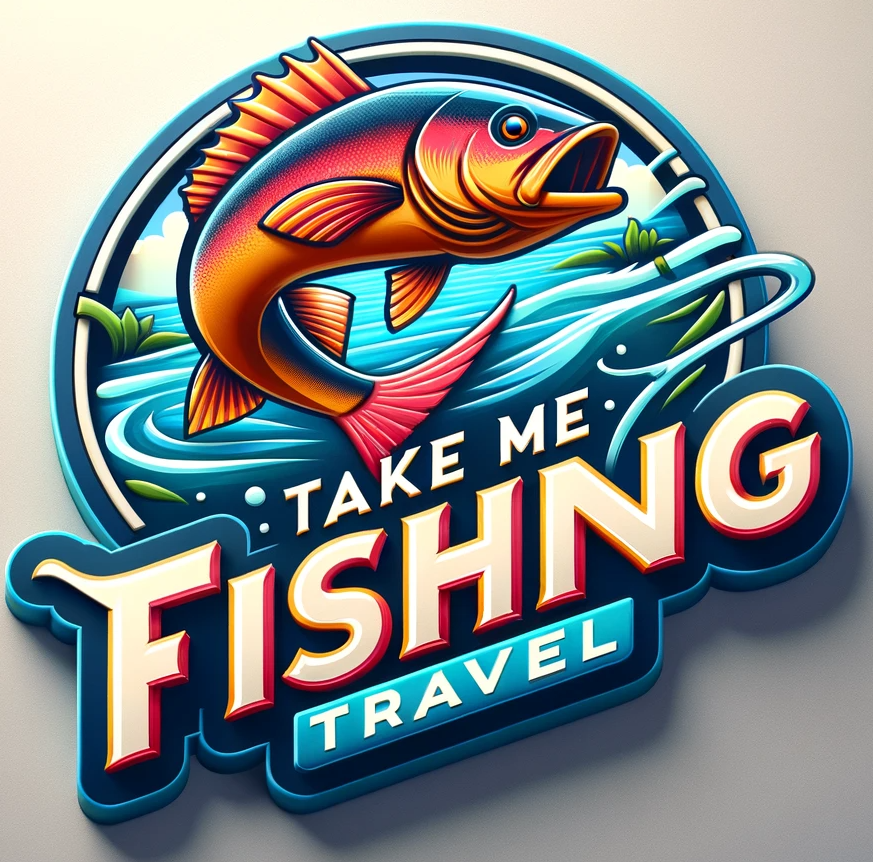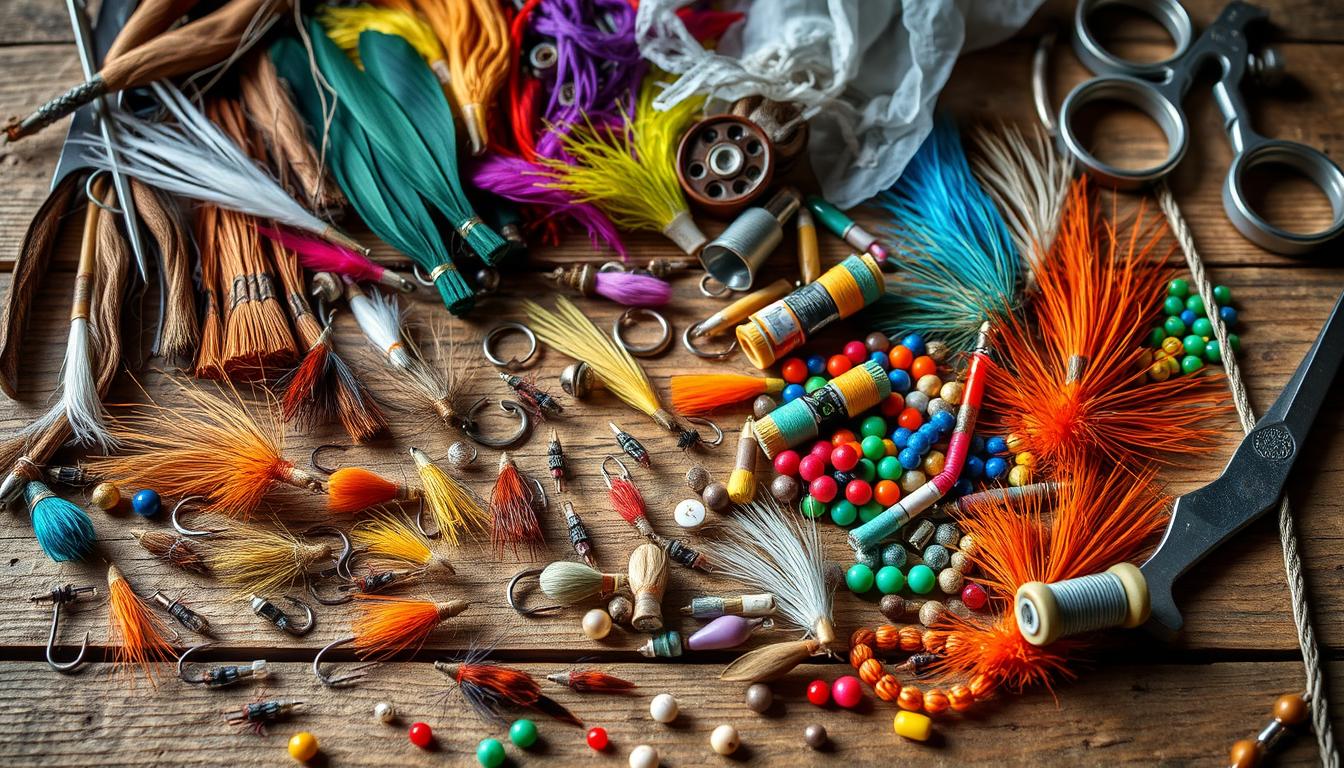This post contains affiliate links.
Sitting at your fly tying bench is uniquely calming. The world’s noise fades away as you focus on your craft. This is true for both seasoned anglers and beginners. Working with top-notch fly tying materials, you feel a strong bond with fishing’s art. I began with a simple kit and vise. Now, fly tying is a hobby I love, filled with creativity and a connection to nature.
When you dive into fly tying, you’ll see endless material options. There are over 10,000 types, like soft feathers and strong hooks. This variety shows the community’s depth and innovation. The quality of materials and tools, from brands like Hareline to Wapsi, is key. Great quality brings our creations to life, connecting us to the water and fish.
Start with the right materials. Look for trusted brands, from those great for beginners to experts. Understanding each material’s use is important. With high-quality materials and suppliers, your time spent tying flies is rewarding. Every fly you make will be ready for success.
Key Takeaways
- The therapeutic and immersive nature of fly tying connects anglers deeply to their craft.
- Quality materials are essential, with extensive catalogs offering over 10,000 different items.
- Brands like Hareline, Semperfli, Danville, and Wapsi provide top-tier fly tying supplies.
- Understanding the versatility and application of materials is crucial for effective fly tying.
- Investing in premium fly tying gear from reliable fly tying materials suppliers enhances both the experience and the outcome.
Understanding Fly Tying Hooks
Choosing the best fly tying hooks makes a big difference in fishing success. Knowing about hook sizes and styles is crucial for catching trout and bass. Let’s explore the details of these small but important tools.
Hook Sizes and Applications
There are many hook sizes to pick from based on the fly you’re making. For small beetles, you might use tiny hooks smaller than #20. For bigger grasshoppers, #6 2XL hooks work best. But most often, sizes #10 to #18 are best. Hook sizing can be confusing without a standard rule. Yet, brands like Tiemco (TMC) provide helpful hook charts.
Dry fly hooks have a down eye, straight shank, and a precise bend for better floating. Nymph hooks, on the other hand, have heavier wire to sink and hook better. There are also special hooks for making bass flies, like the “Stubby T” from Umpqua, perfect for foam terrestrials.
| Hook Type | Ideal Sizes | Features |
|---|---|---|
| Dry Fly Hooks | 12, 14, 16 | Down eye, straight shank, light wire |
| Wet Fly Hooks | 10, 12 | Slightly heavier wire, nymph-compatible |
| Streamer Hooks | 6 | Long shank, strong wire |
Barbed vs. Barbless Hooks
The choice between barbed and barbless hooks is widely debated. Barbless hooks are better for trout fishing because they are easier to remove and less harmful. But if you’re making bass flies and only have barbed hooks, there’s a simple solution. Just flatten the barbs with pliers.
In conclusion, the hooks you choose are key to your fishing success. Picking the right hooks is essential whether you’re after trout or bass. This knowledge sets the base for a successful fishing trip.
The Importance of Fly Tying Threads
Choosing the right fly tying threads is crucial in making the perfect fly. These threads are a key part of having the necessary tools and skills. The right thread impacts the fly’s durability, look, and how well it works in the water.

Thread Color
Fly tying threads come in many colors to fit different fly patterns. Although some flies need specific colors, black is always a good choice. The thread color helps the fly look like real insects and baitfish to fish. It also helps in building the fly’s body, making it more appealing.
Thread Size
Threads are measured in denier or aught (0) sizes. In the aught system, smaller numbers mean thicker threads for big flies. The denier system, which is used by brands like UTC Ultra Thread, varies from 70 to 280. Finer threads are used for delicate flies and heavier ones for bigger, stronger flies. For instance, 8/0 UNI-Thread is roughly 72 denier, and 6/0 Danville’s is 70 denier.
Thread Material
Threads can be made from different materials like nylon, polyester, and GSP. Nylon threads, around since the 1930s, are strong and have some stretch. They come in many colors. Polyester, while less elastic than nylon, is still widely used. GSP threads are strong and flexible but slippery, great for specific tasks like spinning deer hair.
| Material | Characteristics | Popular Brands |
|---|---|---|
| Nylon | Strong, stretchy, vibrant | UNI, Danville |
| Polyester | Less stretch, strong, slightly muted colors | Wapsi, Au Ver á Soie |
| GSP | Extremely strong, flexible, slippery | VEEVUS |
Choosing the right threads is vital for both the fly’s durability and your tying experience. Understanding thread color, size, and material helps refine your skills. This ensures you create effective and attractive flies, leading to better fishing success.
Selecting Fly Tying Feathers and Hackle
Fly tying feathers are key for any angler. It’s crucial to pick the right ones for your needs. This means knowing about the types available, like wood duck and CDC feathers. Each has unique features, like floatant properties, important for fly tying.
Types of Feathers
Many feathers are used in fly tying. Anglers love Wood Duck feathers for classic flies and Mallard flanks for color variety. Teal duck flanks are great for softer fibers. CDC feathers, known for buoyancy, help flies float thanks to their structure. Duck quills are picked for durable wings in wet and dry flies.
Ruffed Grouse feathers mix browns, blacks, tans, and whites, ideal for soft hackles. Guinea fowl feathers stand out in salmon flies with their mottled look, thanks to Whiting Farms.
Hackle Variations
Hackle is essential for dry flies, found in saddle or cape forms. Saddle hackle provides uniform size for consistent flies. Cape hackle, meanwhile, offers a size range for various patterns.
For new tiers, starting with grizzly, brown, and black hackles is smart. These colors mimic natural prey. Quality materials make your flies more effective and long-lasting.
“Choosing the right fly tying feathers and hackle can transform a fly from merely good to truly exceptional. It’s all about the details and the natural appearance.” – Experienced Angler
| Feather Type | Primary Use | Notable Characteristics |
|---|---|---|
| Wood Duck | Classic salmon flies | Heavy black and white barring |
| Mallard Flank | Substitute for wood duck | Can be dyed to match different colors |
| CDC | Enhancing buoyancy | Natural floatant, fiber network increases surface tension |
| Duck Quills | Winged wet flies, dry fly wings | Used for creating durable and long-lasting wings |
| Ruffed Grouse | Soft hackles, wing slips | Natural mix of browns, blacks, tans, whites, speckled patterns |
| Guinea Fowl | Classic salmon flies | Mottled appearance, bred by Whiting Farms |
Choosing the Right Fly Tying Tools
Selecting the right fly tying tools is key for anglers wanting to make great flies. With decades of experience, it’s clear that quality tools make a big difference. What are the must-haves? Let’s find out.

The fly tying vise is crucial. The Renzetti Traveler 2300 Series is known for its durability and rotary function. It costs about $250. The ability to rotate gives a full view of the fly. This makes tying complex patterns easier.
Good scissors are essential for cutting. You need two types: Westcot scissors for rough work and Dr. Slick Razor Scissors for precision. They cost $20 and $25, respectively. Sharp scissors ensure clean cuts and less waste.
A good bobbin is key, too. Dr. Slick’s glass-lined bobbin, costing $15, feeds thread smoothly. This reduces thread breaks. Pairing this with a bobbin threader can make your work much easier.
- Bodkin Tool: $5
- Whip Finisher: $8 (Dr. Slick)
- Hackle Pliers: $10 (Tiemco)
- Hair Stacker: $30 (Renzetti)
- Comb/Dubbing Brush: $12 (Stonfo)
- Dubbing Spinner: $14 (Dr. Slick)
Choosing the right equipment is critical. Tools like Tiemco Hackle Pliers protect delicate feathers. A bodkin tool makes adjustments easy. A whip finisher, on the other hand, is great for secure knots. These are important for making durable flies.
Consider specialty tools like hair stackers and dubbing spinners. They are designed for specific tasks, like working with deer hair or making thoraxes. Fly tying tools have improved a lot recently. Today, there are tools like spring vises with multiple functions and made of high-quality steel.
Don’t forget about good adhesives. Loon Outdoors’ water-based head cement ($7) keeps flies together. Wapsi Premium dubbing wax ($3) improves material stickiness. Z-Ment super glue ($4) and Solarez Bone Dry UV resin ($20) are great for fast, strong bonds.
“Investing in high-quality fly tying tools not only simplifies the tying process but also elevates the overall enjoyment of this meticulous craft.”
Choosing the right fly tying tools is about quality, function, and value. For more detailed recommendations on fly tying equipment, check out the full guide here.
Best Fly Tying Materials for Beginners
Entering the world of fly tying can be exciting and a bit daunting. But, beginning with the right starter fly tying materials makes the process easier. Below, we’ll explore essential items for newbie fly tyers.
First, hooks are key. Use size 12 & 14 for dry flies and size 10 & 12 for wet flies and nymphs. For streamers, go for size 6. In places like Wisconsin, barbless hooks are becoming popular. They’re easier to remove and help in conservation efforts.
Thread choice is important, too. Start with size 8/0 for dry flies and 6/0 for nymphs and wet flies. For bigger flies like streamers, use 3/0. Also, having wire from 0.4mm to 0.8mm will add variety to your fly tying kit.
- Feathers: A pheasant skin offers many useful feathers. Favorites include Whiting grizzly and medium barred ginger saddles for size 14-18 flies.
- Hackle: Go for high-quality genetic hackle, such as saddles and capes. They have long feathers, dense barbs, and bend well.
- Hair: Cow elk hair is great for beginners. It suits a variety of fly patterns well.
Starting with a basic kit sets you up for later success. Look for beginner tying kits with everything you need in one package. A good starting budget is between $50-$75. Here are some product suggestions:
| Item | Recommended Product | Price |
|---|---|---|
| Vise | Colorado Anglers Super AA Vise 103 | $16.26 |
| Bobbin | ECO Flared Fly Tying Bobbin from Dr Slick | $5.29 |
| Scissors | Loon Outdoors Ergo Arrow Point Scissors | $14.98 |
| Whip Finishing Tool | Daxin Whip Finishing Tool | $7.19 |
| LED Light | Fly Tying LED Lite | $18.00 |
Concentrating on the basic materials and tools outfits you well for fly tying. Good luck and enjoy your new hobby!
Fly Tying Dubbing: What You Need to Know
Fly tying dubbing is vital for making fly bodies and heads. There are two main types: natural and synthetic dubbing. Natural dubbing sinks because it absorbs water. Synthetic dubbing floats, which can make your fly more effective.
Natural vs. Synthetic Dubbing
Knowing the difference between natural and synthetic dubbing is key:
- Natural Dubbing:
- Hare Dubbing: 15%
- Rabbit Fur Dubbing: 12%
- Seals Fur Dubbing: 14%
- Synthetic Dubbing:
- Antron Dubbing: 10%
- Gleamy Dubbing: 7%
Applying Dubbing
Learning how to apply dubbing is crucial. The steps are:
- Start with a tiny pinch of dubbing.
- Spin it evenly onto your thread.
- Wrap the thread around the hook to form the body or head.
The right application boosts your fly’s looks and helps it mimic prey better. For tiny flies, use fine dubbing. For bigger ones, coarse is better. Some dubbings, like Super-Fine Dry Fly Dubbing, float well but might need extra shine to attract more.
Essential Fly Tying Wires and Their Uses
Choosing the right fly tying wires is key to making top-notch flies. They help adjust the fly weight control and are crucial for designs like the zebra midge. This design is a hit for nymphing patterns because it sinks well and quickly, making it a go-to for fishers.
Fly tying wires vary in size from 0.4 mm to 0.8 mm. This range allows for tying flies with different weights and floats. By wrapping wire around the hook, you can set the fly’s depth just right. This ensures it acts as needed across various water types.
Understanding wire types is great for all anglers, whether new or experienced. Copper wire is heavy, perfect for getting nymph flies down fast. Tippet wire, on the other hand, is lighter. It adds a subtle shine and strength to the fly without making it too heavy.
While natural materials have been popular for a long time, synthetics are catching up. They come in many colors and last longer. For instance, nylon and polyester are great for making bright, durable flies. Yet, for those who prefer a natural look, deer hair is excellent. It keeps dry flies floating on top.
To excel in fly tying, you need to mix beauty with function. With the right techniques and materials, your flies will not only work well but also look unique. This adds a special touch to your fishing collection.
Here’s a guide to help you with different fly tying wire types and their uses:
| Wire Type | Usage |
|---|---|
| Copper Wire | Ideal for sinking nymph flies |
| Tinsel Wire | Great for ribbing and adding flash to fly bodies |
| Nylon Wire | It’s a synthetic choice offering a wide range of colors and durability |
| Tippet Wire | Lightweight; it adds durability and a bit of shine |
The right fly tying wires are crucial for crafting successful flies. With proper knowledge and materials, your fly tying can become an art. This will not only meet your fishing needs but also make your experiences richer.
Using Eyes and Bead Heads in Fly Tying
Fly tying is not just about copying insect looks. Using fly tying eyes and bead heads right can boost both effectiveness and looks. They help fly fishers make a fly from good to great.
Types of Eyes and Bead Heads
There are many kinds of fly tying eyes. Hourglass eyes and dumbbell eyes do two jobs: they add weight and look like real eyes. This is key for streamer flies that go after big fish.
- Hourglass Eyes: Great for balance and weight, often used in streamer fly patterns.
- Lead Dumbbell Eyes: They come in sizes like XL (49 grams), L (21 grams), S (10 grams), and XS (8 grams). They’re useful and not pricey.
- Bead Chain Eyes: They come in many colors and sizes. They’re cheaper, especially if you don’t buy from fly-specific shops.
- Tungsten Bead Heads: These stand out for how they sink flies fast thanks to their weight-to-size ratio.
Choosing the Right Weight
Choosing the right weight for eyes and bead heads is key. It influences how a fly sinks, stays balanced, and how you cast it. Consider these:
- Fly Type: Streamer flies work better with heavier options like lead dumbbell eyes to control depth.
- Fishing Conditions: In fast water, heavier bead heads make sure flies sink to the right depth fast.
- Fly Aesthetics and Functionality: The right combo of eyes and bead heads not just looks good but also fishes well.
| Type | Material | Advantages |
|---|---|---|
| Hourglass Eyes | Metal | Weight, balance |
| Bead Chain Eyes | Metal/Plastic | Cost-effective, variety |
| Tungsten Bead Heads | Tungsten | High sink rate |
Using the best types and weights of eyes and bead heads can make your streamer flies look and perform better. For deep insights and tips on fly fishing gear, check out this guide.
Fly Tying Hair: Elk and Deer Hair
Fly tying is a craft loved by many. The choice of elk hair versus deer hair is big. Each kind of hair makes your flies look amazing in different ways.
Choosing Between Elk and Deer Hair
Elk hair or deer hair? Your choice depends on what you need. Elk hair is great for caddis patterns because it’s tough and doesn’t soak up water. However, deer hair is perfect for Comparadun flies. It’s fine and bends easily. There are many hair types such as Cow Elk Spinning hair for newbies and Spinning Deer hair for big, detailed patterns. Moose hair is less common but strong, ideal for tails and brushes.
How to Spin Hair
Spinning hair is a skill for making flies look real. It adds size and shape, like bug thoraxes or heads. Choose the right deer hair by its hollowness and fiber length. Texas hair is dense and Northern hair is more bendable. This helps create perfect flies. Pronghorn and caribou hair are also good for spinning. They are hollow, suitable for bodies. This spinning method makes wings or tails stand out in your fly tying projects.
Conclusion
Fly tying is more than just a key tool for fishing; it’s a rewarding craft. It brings joy and improves fishing trips. By learning fly tying, anglers get to perfect their gear and deeply understand the elements of a great fly fishing outing. Mastering the small details, like hook sizes and the art of hair spinning is essential. Each part of fly tying plays a big role in making an effective and attractive fly.
Getting the right materials shouldn’t mean spending a lot of money. You can find much of what you need at regular craft stores for less. For example, colored threads in sewing kits can cost less than $5. Beads and foam for flies come in large packs and sheets at craft shops, saving you tons. While craft store options might not always match fly shop quality, they help you stay organized without breaking the bank.
Since the 1800s, natural materials like deer hair and marabou have been top choices for flies. They make flies float or move realistically in the water. By the mid-1900s, synthetic materials became popular for their affordability and variety of colors. Yet, some traditional items, like copper wire for nymphs and chenille for bulk, remain irreplaceable. Whether you use old-school or new-age materials, fly tying lets you add a personal touch to fishing, enriching each trip.
FAQ
What are the most essential materials for fly tying?
What’s the importance of the different sizes of fly tying hooks?
Should I use barbed or barbless fly tying hooks?
How do I choose the right fly tying thread?
What types of feathers are commonly used in fly tying?
What tools are essential for fly tying?
What are the best fly tying materials for beginners?
What is dubbing, and how is it applied?
How does fly tying wire affect a fly’s performance?
What types of eyes and bead heads should I use?
How do I choose between elk and deer hair for fly tying?
What is hair spinning, and why is it used?
This post contains affiliate links.

